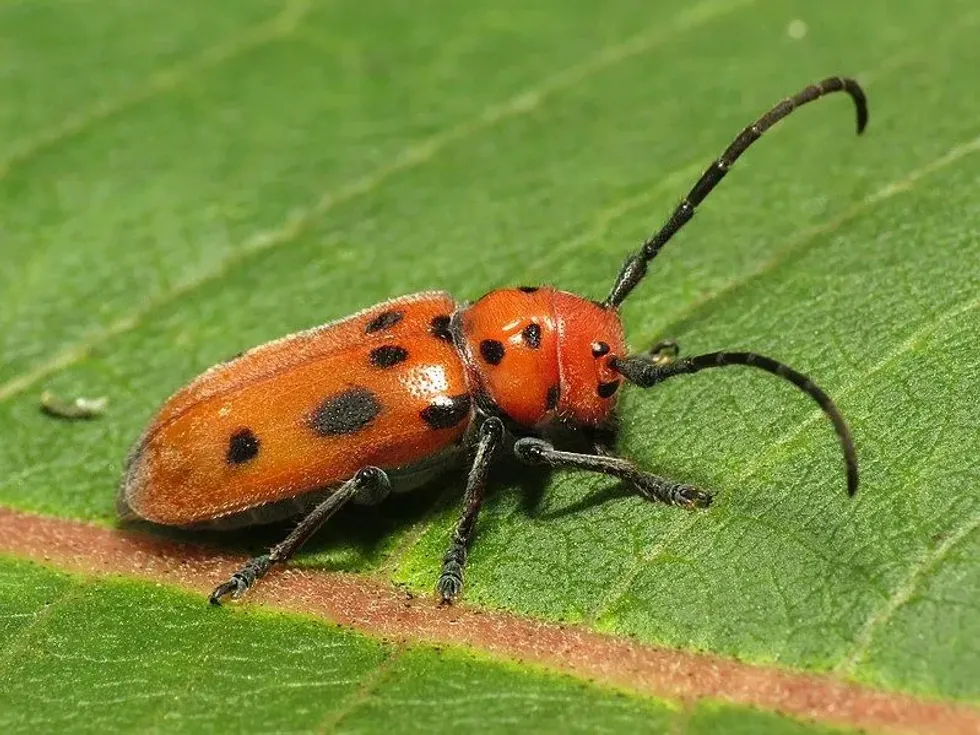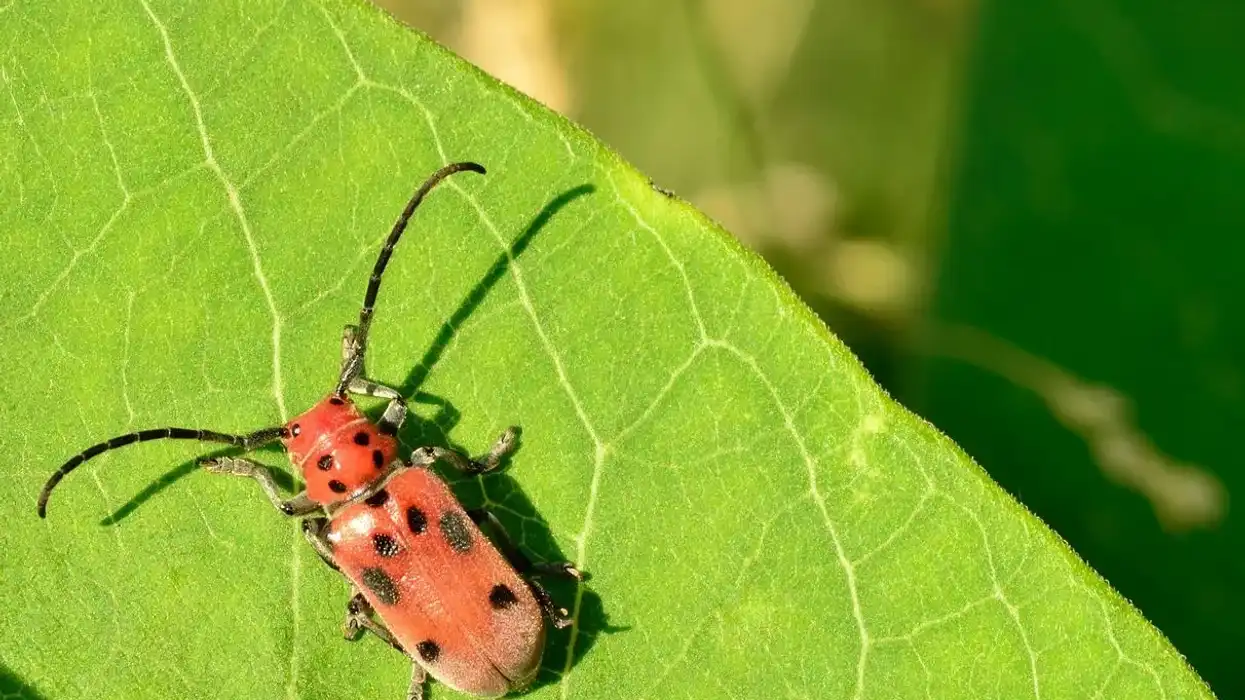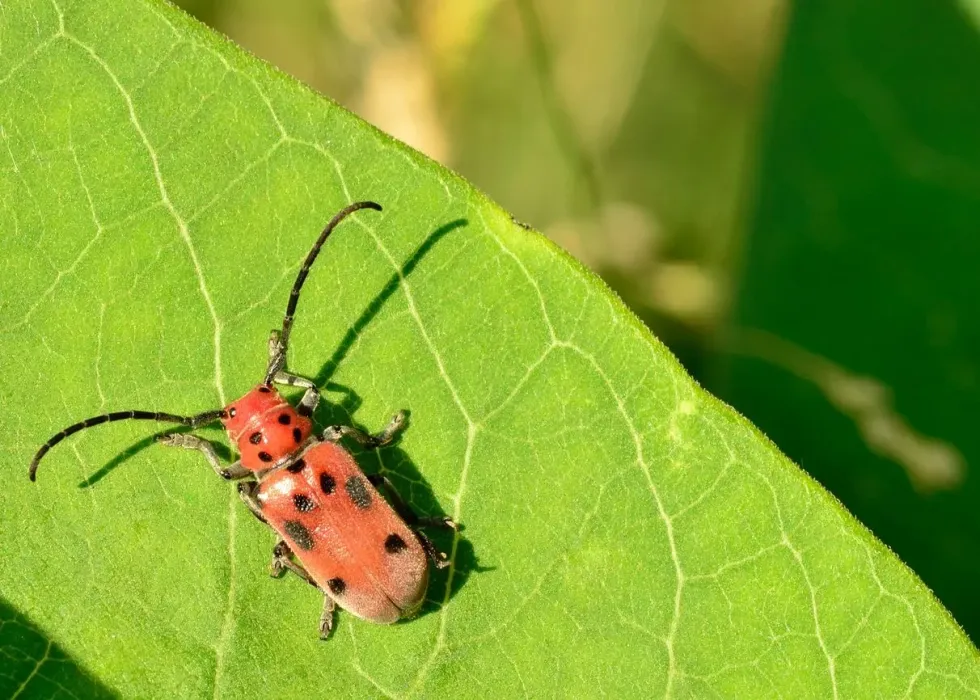Fun Milkweed Beetle Facts For Kids

If reading about various kinds of organisms from the largest ones to the tiniest ones is what your child likes, then this is just the right place for them to be. The section below talks about this particular kind of beetle called milkweed beetles (Tetraopes tetrophthalmus).
The name itself sounds so different from other kinds of bugs. The only probable reason behind such an odd name is their diet.
The very diet of these tiny insects revolves around plants, specifically milkweeds, which are quite dangerous for other plant species. This fact is precisely why these bugs are so important, because they feed on something that is harmful to other fauna.
Although there is no particular specific dwelling place for them, there are regions where they can be found in large numbers when compared to other areas. It is a well-known fact that milkweed beetles mostly live in North America and can be easily seen in the grasslands or the fields there.
We have answered various questions on the species.
You can read fun facts about these insects and learn all about what they look like, how they communicate, whether they are cute or not, what is their size, how much do they weigh, and so much more. You will also find some unknown facts about these insects that you might not have known before.
For example, they can be pretty poisonous as they can literally grow toxins inside them, you will also know whether is it safe to have them as pets or not.
Below are some of the most peculiar and interesting facts about milkweed beetles. You can also check out our facts on weevil beetles or blister beetles.
Milkweed Beetles Interesting Facts
What type of animal is a milkweed beetle?
The species belongs to the family of Lygaeidae, and is a medium-sized bug.
What class of animal do milkweed beetles belong to?
Milkweed beetles belong to the Insecta class of animals.
How many milkweed beetles are there in the world?
Though the stats present for the population of this species isn't quite transparent, the approximate numbers state that there are between 13 and 15 species of milkweed bug dwelling around the globe.
Where do milkweed beetles live?
Milkweed bugs are found exactly where the milkweed plant (milkweed Asclepias) survives. That is where they can be easily spotted, so near parks, fountains, twigs, in the grasslands and even in the gardens found along the roadsides.
Their habitat entirely depends on the availability of their food. Also, the culture of milkweed bugs is quite easy as they don't require soil nor any specific plant material for their survival, all they require is good milkweed plant leaves to feed on.
What is a milkweed beetle's habitat?
Although there is no particular specific dwelling place for them, there are regions where they can be found easily. Milkweeds beetles are known to reside in North America and can be easily seen in the grasslands or fields there.
The specific countries they can be found in are northern countries such as, Canada, Mexico, and the United States Of America.
Who do the milkweed beetles live with?
These little tiny creatures usually prefer living in groups. However, these groups aren't that huge and neither are they territorial in nature. They just prefer living in small-sized groups (which can easily be spotted on the plant stem or leaves).
How long do milkweed beetles live?
While their incubation period lasts for approximately four to five days, the molt is known to last for six days. After which, the lifespan of a beetle is roughly a month or a maximum of six weeks.
How do they reproduce?
There are two varieties of milkweed bugs called the Oncopeltus fasciatus (large milkweed) and the Lygaeus kalmii. The mating season for both of these start in the spring season.
Although these two belong to different varieties of the milkweed beetle, their habits and characteristics tend to be quite similar. They go through the same metamorphic process in order to attain maturity.
The life cycle of a milkweed beetle begins when the adult males make sounds to attract the female beetles. Their mating season begins at the end of spring and the beginning of summer.
After which the eggs are laid dozens at a time, for a period of 30 days making the egg count roughly 2000 plus. It takes approximately six to seven days for the eggs to hatch. The major difference between the two adults of both species of milkweed beetle, is the status of their metamorphosis stage.
Summer is the breeding season for the red beetles, since this is when they tend to lay their eggs.
Milkweed bugs are known to undergo what is often referred to as 'incomplete metamorphosis'. This means, as soon as the milkweed bugs as born (milkweed beetle larvae), they look very similar to the adults and it is difficult to tell the young (milkweed beetle larvae) apart from the fully grown beetles.
The only difference, between the young (milkweed beetle larvae) and the adults, is the absence of functional reproductive organs.
These organs only become functional once the young have undergone their molt stage. Whereas, the milkweed leaf beetle, on the other hand, are known to go through the entire metamorphosis process at once, in a form that is quite similar to the butterfly.
The process of a milkweed bugs young turning into an adult is called the molting phase and it has approximately five proper stages. After the growing up process, these little babies (now adults) are out in the world of survival.
However, they spend their entire life cycle protected from predators since they spend most of their time huddled up in the milkweed plants seed or branches. The predators, hence, cannot feed on the beetles or their eggs.
What is their conservation status?
Though the stats present for the population of milkweed beetles isn't quite transparent, the approximate numbers state that there are 13 to 15 species of milkweed beetles dwelling around the globe. Because of this, the conservation status is marked as Not Extinct by the IUCN.
Milkweed Beetle Fun Facts
What do milkweed beetles look like?
These are tiny little beetles with a bright red x shape on their backs and beautiful white spots printed on the wings. The adult beetles are usually seen with two bright dots on their back which separated by a bar.
The bright mix of colors (red and black) might make them look quite dangerous but to be honest, they aren't. They are also equipped with two antennae, and have an estimated four eyes.

How cute are they?
Milkweed beetles (Asclepias) are so tiny and have such beautiful color combinations on their entire body that it overall makes them look super adorable.
How do they communicate?
There is very little to no information available as to how these milkweed beetles communicate.
How big is a milkweed beetle?
A beetle isn't really expected to be huge. An average large milkweed bug beetle is thought to be approximately 3-4 in (7.6-10.1 cm) long. They are 10 times smaller than a sparrow.
How fast can milkweed beetles move?
There is no specific information given on how fast this species can move.
How much do milkweed beetles weigh?
These milkweed beetles (Asclepias) usually tend to not maintain a particular weight due to their vegetative diet (they have a very slow growth). However, its estimated that they weigh around 0.01-0.04 lb (7-21 kg).
What are the male and female names of the species?
The adult female and males of this insect have no specific names given. They are both known by the same scientific name.
What would you call baby milkweed beetles?
The newly born infants, or offspring, of milkweed beetles are called nymphs. They have an orange shade all over their body and their prime motive is to eat well in order to complete their metamorphosis process effectively.
What do they eat?
Milkweed leaf beetles are known to feed on milkweed, especially the parts of the plants like the seeds, the buds, the stem, or the leaves. They spend their entire life feeding on the plants and and can easily be spotted there. They are known to be hardcore herbivores, hence seeds are their primary diet.
Are they poisonous?
Milkweed plants are quite poisonous but the red milkweed beetles, or the milkweed bug, aren't really dangerous. They consume the milkweed plantation in order to protect themselves from predators, as they ingest the toxicity so predators don't want to feed on them.
Would they make a good pet?
Although most people don't really prefer petting beetles, if you are keen on petting one then they can be taken care of in a tight-fitting container, as long as you provide them with all the nutrients they need and other necessary requirements.
Did you know...
One of the most interesting yet peculiar things about these insects is the way they feed. What they do is they put their long proboscis inside the milkweed and use this to suck and eat the inside of the plant.
Gardeners are opting to have milkweed plants in their gardens, as the toxins that are found in these plants protect the monarch butterflies from predators. These plants are quite toxic but the bodies of monarch butterflies tend to be immune to it; therefore the presence of these milkweed plants and beetles protect the beautiful butterflies.
People usually get confused between the milkweeds bugs and milkweed leaf beetle. The prime difference between the two is the status of their metamorphosis stage.
Milkweed leaf insects are known to undergo incomplete metamorphosis, that is as soon as they are born they look very much similar to the adults but they lack functional reproductive organs. Whereas, milkweed bugs, on the other hand, are known to go through the entire metamorphosis process, very similar to what butterflies experience during their metamorphosis stage.
There are various kinds of milkweed beetles, such the swamp milkweed beetle, blue milkweed beetle, red milkweed beetle (Tetraopes tetrophthalmus), as well as the milkweed longhorn beetle.
Milkweed bugs are medium sized bugs found that are generally found in North American countries, Canada and sometimes Mexico.
Late spring tends to be the prime mating season for these milkweed beetles, but some species of the milkweed bug prefer to lay their eggs in early summer.
People tend to think that milkweed bugs might be threat to monarch caterpillars, and monarch butterflies. However, monarch caterpillars are safe around these milkweed beetles as they are herbivores. In fact, the very presence of milkweed beetles help monarch caterpillars.
Asclepias are a variety of plants also called milkweed plants.
The larvae of these beetles tend to feed on the roots of milkweed plants, instead of the leaves and seeds like their adult counterparts.
These beetles have antennae. The antennae are placed right near the eye and help them get hold of their surroundings.
How do the milkweed beetles eat milkweed plants?
These (red milkweed beetles) are hardcore herbivores and prefer eating seeds and parts of the milkweed plant.
The adult class of these insects are particularly known to feed on leaves, buds or other plant parts (they generally avoid consuming sticky latex which could further cause trouble to their mouthparts).
What's special about the milkweed beetles?
These insects are considered to be special because of their feeding style. These milkweed bugs are known to feed on the milkweed plants.
The higher they consume the milkweed plants, the lower the count of milkweed plants will be, which is quite beneficial. The lower the number of milkweed plants in your garden, means the lower the chances of them taking over your beautiful garden.
The second attribute that makes them quite special is the fact that they are Hemiptera and therefore they are used as research insects in laboratories in order to gain more knowledge about their life cycle or body movements.
Here at Kidadl, we have carefully created lots of interesting family-friendly animal facts for everyone to discover! Learn more about some other arthropods including hercules beetles, or longhorn beetles.
You can even occupy yourself at home by drawing one of our Milkweed beetle coloring pages.
We Want Your Photos!
More for You
Bachelor of Commerce specializing in Accounting and Finance, Master of Business Administration

Divya RaghavBachelor of Commerce specializing in Accounting and Finance, Master of Business Administration
With a diverse range of experience in finance, administration, and operations, Divya is a diligent worker known for her attention to detail. Born and raised in Bangalore, she completed her Bachelor's in Commerce from Christ University and is now pursuing an MBA at Narsee Monjee Institute of Management Studies, Bangalore. Along with her professional pursuits, Divya has a passion for baking, dancing, and writing content. She is also an avid animal lover who dedicates her time to volunteering for animal welfare causes.
Bachelor of Arts specializing in Political Science and Sociology

Spandana KantamBachelor of Arts specializing in Political Science and Sociology
Spandana holds a Bachelor's degree in Political Science from Acharya Nagarjuna University. She has a passion for writing and enjoys reading crime and thriller novels while listening to RnB music in her free time.
Disclaimer
1) Kidadl is independent and to make our service free to you the reader we are supported by advertising. We hope you love our recommendations for products and services! What we suggest is selected independently by the Kidadl team. If you purchase using the Buy Now button we may earn a small commission. This does not influence our choices. Prices are correct and items are available at the time the article was published but we cannot guarantee that on the time of reading. Please note that Kidadl is a participant in the Amazon Services LLC Associates Program, an affiliate advertising program designed to provide a means for sites to earn advertising fees by advertising and linking to Amazon. We also link to other websites, but are not responsible for their content.
2) At Kidadl, we strive to recommend the very best activities and events. We will always aim to give you accurate information at the date of publication - however, information does change, so it’s important you do your own research, double-check and make the decision that is right for your family. We recognise that not all activities and ideas are appropriate for all children and families or in all circumstances. Our recommended activities are based on age but these are a guide. We recommend that these ideas are used as inspiration, that ideas are undertaken with appropriate adult supervision, and that each adult uses their own discretion and knowledge of their children to consider the safety and suitability. Kidadl cannot accept liability for the execution of these ideas, and parental supervision is advised at all times, as safety is paramount. Anyone using the information provided by Kidadl does so at their own risk and we can not accept liability if things go wrong.
3) Because we are an educational resource, we have quotes and facts about a range of historical and modern figures. We do not endorse the actions of or rhetoric of all the people included in these collections, but we think they are important for growing minds to learn about under the guidance of parents or guardians.







